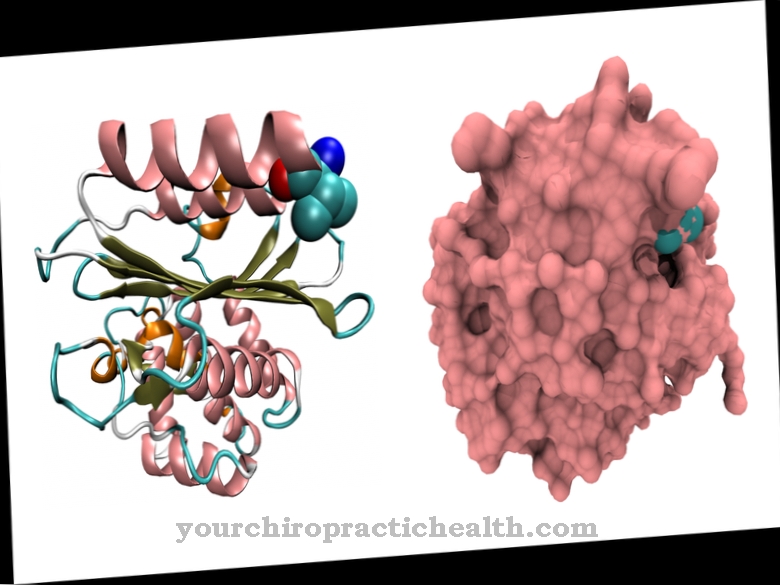What is neuralgic shoulder amyotrophy?

© sfischka - stock.adobe.com
Vaccinations, virus infections, operations, injuries or strenuous physical exertion usually precede the disease. In most patients, however, no tangible cause can be found. Neuralgic shoulder amyotrophy is characterized by severe pain in the shoulder and arm muscles, which can culminate in paralysis.
These symptoms are similar to those of the cervical disc herniation. A differential diagnosis can be ruled out by suitable examinations. Neuralgic shoulder amyotrophy mainly affects men and usually occurs between the ages of 20 and 60.
It is seldom hereditary and in this case usually begins in the first or second decade of life. The incidence is estimated to be 1.64 per 100,000 people annually. Most of the time the right arm is affected, although it can occur on both sides.
causes
The cause of the development of the neuralgic shoulder amyotrophy is unknown. However, a connection with the Coxsackie virus and the cytomegalovirus could be found. Vaccinations, physical exertion and heroin addiction are also suspected of favoring the development of the disease.
As a result of the factors mentioned, the sheaths of the brachial plexus become inflamed. This leads to faulty impulse transmission, which in turn causes severe pain and paralysis. The nerve is damaged. Muscle fibers can therefore no longer be properly controlled and become narrower. If the inflammation subsides, the sheaths re-form. Their regeneration is a lengthy process that can take up to a year.
The cause for this are the slowly renewing damaged nerve components. Other scientists see circulating immune complexes as the cause of plexus damage. These are protein compounds that can be found in the blood. Genetic variants are rare and should be considered when investigating.
Symptoms, ailments & signs
Neuralgic shoulder amyotrophy begins with severe pain in the upper arm and shoulder area. This is difficult to bear for many sufferers and lasts for several days to weeks. It is a pain that is present in both movement and rest. If it subsides, the affected arm becomes weak. Slight paralysis of the shoulder and upper arm muscles are the result. However, these can lead to complete arm plexus palsy (paralysis).
Because of the inflammation, it is difficult or impossible for the patient to raise the inflamed arm. Affected muscles are Deltoid muscle (Deltoid), Supraspinatus muscle (Upper bone muscle), Infraspinatus muscle (Lower bone muscle), Serratus anterior muscle (anterior saw muscle) and Trapezius muscle (Trapezius muscle). Of the Cervical plexus is usually not affected by the inflammation. Inflammation of the diaphragm, biceps brachii (biceps), individual nerves and nerve branches rarely occurs. Sensory disorders in the arm and hand area can also be observed in a few patients. In most cases, atrophy (tissue loss) of the denervated muscles can be observed. A shoulder blade protruding when moving (Scapula alata) is typical of neuralgic shoulder amyotrophy.Diagnosis & course of disease
The doctor will first conduct a medical history and neurological exams. Blood tests are atypical for this clinical picture. However, increased antibodies against the Coxsackie virus can be detected in the blood. A positive result can indicate a neuralgic shoulder amyotrophy.
Analyzes of the nerve water are used to determine a possible increase in total protein. If a nerve fluid test is positive, this may indicate cell damage or an increase in inflammatory cells. Since the symptoms of neuralgic shoulder amyotrophy resemble those of the irritation of the neck nerve roots (caused by a herniated disc or wear and tear), a misdiagnosis is occasionally made.
In this case, an electromyographic examination can lead to a clear result. In this method, muscle activity is measured using concentric needle electrodes. If there is still any doubt, magnetic resonance imaging (MRI) is useful to detect cervical disc herniation and wear and tear on the cervical spine.
Complications
In about 25 percent of all cases, the neuralgic shoulder amyotrophy does not heal completely. Then the shoulder joint remains permanently paralyzed. The healing process depends on how the disease develops in the first two months. But even if the healing process is ideal, it usually takes two years to clear the symptoms.
In neuralgic shoulder amyotrophy, capsule shrinkage occurs in the shoulder joint. Because of this, complications can arise, which initially manifest themselves in symptoms of paralysis. If the rotor cuff is paralyzed, there is a constant risk of dislocation or subluxation. A dislocation means the complete dislocation of the shoulder joint, while a subluxation means an incomplete dislocation.
A bandage should be placed around the shoulder joint to reduce the risk of dislocation. Capsule shrinkage can be reduced with passive movement of the shoulder. Even then, however, there is no guarantee that healing will occur without complications. So far there is no correct treatment concept for this disease, so the patient needs a lot of patience. In addition to pain killers, cortisone is often used.
However, this therapy is controversial because long-term cortisone treatment usually leads to severe side effects. The full picture of Cushing's syndrome can develop. In addition to trunk obesity with a full moon face and water retention in the body, there are also psychological changes. But even without drug treatment, mental problems can arise because the healing process takes so long.
When should you go to the doctor?
Pain in the shoulder or upper arm is the first characteristic of neuralgic shoulder amyotrophy. If they are not caused by current overuse of the body, they must be monitored further. If the pain increases in intensity or if it continues unabated for several days, a doctor's visit is necessary. A pain reliever medication should only be taken in consultation with a doctor. Otherwise further inconsistencies may arise.
If sleep disturbances, inner restlessness or general resilience decrease, a doctor is required. If the daily obligations can no longer be fulfilled or if the usual sporting activities can no longer be performed, it is advisable to consult a doctor. In the case of symptoms of paralysis, restrictions in the musculoskeletal system and poor posture of the upper body, the person concerned needs medical support. Discomfort when turning or lifting the arm are unusual and must be presented to a doctor.
It is necessary to clarify the cause so that there are no further impairments or permanent damage to the organism. Sensitivity disorders, numbness on the skin or hypersensitivity to pressure or touching the affected areas on the body must be examined by a doctor. If the general quality of life declines, or if the symptoms lead to behavioral problems or mood swings, the person concerned should seek medical care.
Treatment & Therapy
Treatment usually begins with the use of so-called opioids. These are centrally effective means that reduce pain. Once the diagnosis has been received, the abduction position promotes the recovery process. In this position, the arm is lifted away from the body. In this way, any stiffening of the shoulder joint capsule (more precisely the rotator cuff) can be counteracted.
Otherwise this leads to dislocation (dislocation) or subluxation (dislocation) of the shoulder joint. An association becomes essential. Most patients (75%) are completely cured within two years of the onset of the disease. Patience is essential. Physiotherapy is required to maintain mobility and strength in the arm and shoulder joint.
It achieves good results in patients with neuralgic shoulder amyotrophy. Since the inflammation of the affected muscles must be stopped, cortisone is often used. The use of this drug is controversial for this and numerous other diseases. When taken regularly, cortisone can cause psychological changes.
It can also lead to gastric bleeding, muscle wasting and other symptoms and diseases. However, rest and exposure to red light have no side effects. These measures are recommended by doctors and physiotherapists.
You can find your medication here
➔ Medicines for painOutlook & forecast
The prognosis is good with neuralgic shoulder amyotrophy. However, the process is extremely protracted and the paralysis only regresses gradually over a few years. About half of those affected complain of pain in the arm area over a longer period of time. In 80 to 90 percent of those affected, the disease heals almost completely over the course of two years. Although minor residual complaints may persist, the overall body functions are generally normal and do not impair the quality of life.
The probability of a complete regression of the paralysis symptoms depends crucially on the healing process in the first months of treatment. If there is no improvement, future paralysis cannot be ruled out. Particularly important for the prognosis are physiotherapy exercises and specific movement exercises under low stress. These are especially important in those cases in which the muscle strength is permanently reduced by the disease. Certain movement sequences have to be relearned in some cases in order to ensure adequate strength build-up in the arms. In rare cases (less than 10 percent), recurrences - a reappearance of the paralysis - can occur.
prevention
No prophylactic measures are currently known.
Aftercare
Despite the limitations that the clinical picture brings with it, those affected should pay close attention to follow-up care. Sensible pain management in combination with rehabilitation therapy offer the best prerequisites for the best possible restoration of the musculoskeletal system. Visits to the physiotherapist help those affected to learn to deal with the symptoms of the disease.
In doing so, excessive strain on the shoulder / neck area, such as heavy lifting and longer, monotonous movements of the arms, should be avoided. Targeted and controlled exercises that are learned as part of physiotherapy and also followed at home are an optimal addition. If the arm and shoulder do not move in the long term, there is a risk of paralysis and muscle loss.
This can be counteracted by means of active and passive physiotherapy. During follow-up care, patients should consciously listen to themselves and clarify with the accompanying doctor and physiotherapist what promises to alleviate the affected area. While some patients tend to prefer cold therapy, others prefer local heat applications and radiation treatments.
A change in diet with low-acid and low-fat foods as well as avoiding alcohol and drugs is also helpful. Patience is the greatest challenge for those affected by neuralgic shoulder amyotrophy, which can last up to two years in the worst case. The more coordinated the daily, but not excessive, exercise recovery training is carried out, the more successful the follow-up will be.
You can do that yourself
People with neuralgic shoulder amyotrophy should pay close attention to the signals from their body. Stressful situations or overexertion are to be avoided. If there is an inflammatory disease, this must always be cured. The sufferer harms himself if he subjects his body to excessive stress before a full recovery.
A stable immune system is required so that inflammations in the organism heal better. This can be supported by a healthy lifestyle and a balanced diet. The consumption of harmful substances such as nicotine and alcohol is to be avoided. The foods should be rich in vitamins. The daily calorie requirement is to be determined according to the existing weight. Any excess weight should be reduced if possible, as this puts additional strain on muscles, bones and tendons. The disease is accompanied by severe pain in the shoulders or arms. Nevertheless, you should not take pain medication on your own responsibility. Rather, relaxation techniques or mental training help to support the mind. In this way the perception of pain can be influenced.
In addition, bad posture or one-sided strain on the body should be avoided. These trigger new complaints and lead to an overall deterioration in wellbeing. If the shoulder becomes permanently paralyzed, the person affected should seek emotional support.Otherwise the risk of psychological complications increases.




.jpg)

.jpg)

















.jpg)



